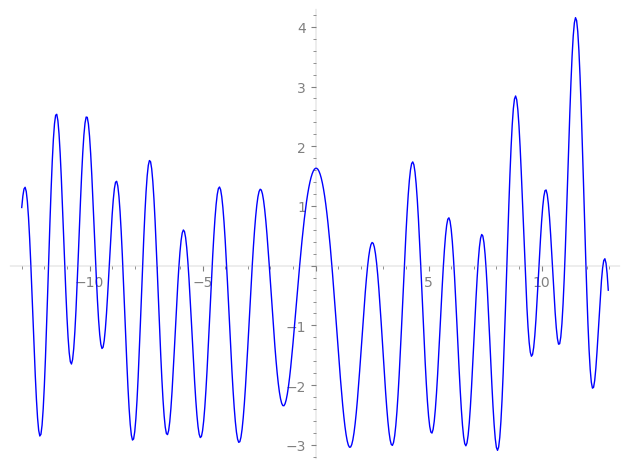| L(s) = 1 | + (0.667 − 0.667i)5-s − 7-s + (−1.57 − 1.57i)11-s + (−1.83 + 1.83i)13-s + 3.40i·17-s + (−3.18 − 3.18i)19-s + 0.793i·23-s + 4.10i·25-s + (−1.73 − 1.73i)29-s − 3.28i·31-s + (−0.667 + 0.667i)35-s + (7.72 + 7.72i)37-s + 7.19·41-s + (5.84 − 5.84i)43-s + 13.0·47-s + ⋯ |
| L(s) = 1 | + (0.298 − 0.298i)5-s − 0.377·7-s + (−0.475 − 0.475i)11-s + (−0.507 + 0.507i)13-s + 0.826i·17-s + (−0.730 − 0.730i)19-s + 0.165i·23-s + 0.821i·25-s + (−0.322 − 0.322i)29-s − 0.589i·31-s + (−0.112 + 0.112i)35-s + (1.26 + 1.26i)37-s + 1.12·41-s + (0.890 − 0.890i)43-s + 1.89·47-s + ⋯ |
\[\begin{aligned}\Lambda(s)=\mathstrut & 4032 ^{s/2} \, \Gamma_{\C}(s) \, L(s)\cr =\mathstrut & (0.986 + 0.163i)\, \overline{\Lambda}(2-s) \end{aligned}\]
\[\begin{aligned}\Lambda(s)=\mathstrut & 4032 ^{s/2} \, \Gamma_{\C}(s+1/2) \, L(s)\cr =\mathstrut & (0.986 + 0.163i)\, \overline{\Lambda}(1-s) \end{aligned}\]
Particular Values
| \(L(1)\) |
\(\approx\) |
\(1.630735564\) |
| \(L(\frac12)\) |
\(\approx\) |
\(1.630735564\) |
| \(L(\frac{3}{2})\) |
|
not available |
| \(L(1)\) |
|
not available |
\(L(s) = \displaystyle \prod_{p} F_p(p^{-s})^{-1} \)
| $p$ | $F_p(T)$ |
|---|
| bad | 2 | \( 1 \) |
| 3 | \( 1 \) |
| 7 | \( 1 + T \) |
| good | 5 | \( 1 + (-0.667 + 0.667i)T - 5iT^{2} \) |
| 11 | \( 1 + (1.57 + 1.57i)T + 11iT^{2} \) |
| 13 | \( 1 + (1.83 - 1.83i)T - 13iT^{2} \) |
| 17 | \( 1 - 3.40iT - 17T^{2} \) |
| 19 | \( 1 + (3.18 + 3.18i)T + 19iT^{2} \) |
| 23 | \( 1 - 0.793iT - 23T^{2} \) |
| 29 | \( 1 + (1.73 + 1.73i)T + 29iT^{2} \) |
| 31 | \( 1 + 3.28iT - 31T^{2} \) |
| 37 | \( 1 + (-7.72 - 7.72i)T + 37iT^{2} \) |
| 41 | \( 1 - 7.19T + 41T^{2} \) |
| 43 | \( 1 + (-5.84 + 5.84i)T - 43iT^{2} \) |
| 47 | \( 1 - 13.0T + 47T^{2} \) |
| 53 | \( 1 + (-3.34 + 3.34i)T - 53iT^{2} \) |
| 59 | \( 1 + (-7.41 - 7.41i)T + 59iT^{2} \) |
| 61 | \( 1 + (-1.93 + 1.93i)T - 61iT^{2} \) |
| 67 | \( 1 + (6.38 + 6.38i)T + 67iT^{2} \) |
| 71 | \( 1 - 3.41iT - 71T^{2} \) |
| 73 | \( 1 + 8.13iT - 73T^{2} \) |
| 79 | \( 1 - 0.0502iT - 79T^{2} \) |
| 83 | \( 1 + (2.29 - 2.29i)T - 83iT^{2} \) |
| 89 | \( 1 + 7.18T + 89T^{2} \) |
| 97 | \( 1 - 1.49T + 97T^{2} \) |
| show more | |
| show less | |
\(L(s) = \displaystyle\prod_p \ \prod_{j=1}^{2} (1 - \alpha_{j,p}\, p^{-s})^{-1}\)
Imaginary part of the first few zeros on the critical line
−8.528838717656843752348796720236, −7.65131064473700392037327401796, −7.01317879659464711579417302309, −6.04406688624507550775551119160, −5.63756948403780843398071012404, −4.57348489082593525301850354603, −3.93575374991458261217165381053, −2.80180917042682796466960023579, −2.04792602654565211293671918281, −0.70405330975283684083003366285,
0.72165983552045763719296352279, 2.30459776869866183447960380434, 2.71217255689420248281796053724, 3.92892658926707958857551399042, 4.65313023264536711559879685343, 5.65518346472140478842006799945, 6.12122592771007671332154163325, 7.18322809834898688784195065183, 7.53670582470579655039068906695, 8.462366755680587101001902482062

